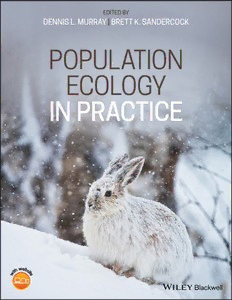
Population Ecology in Practice : Underused, Misused and Abused Methods. PDF
Preview Population Ecology in Practice : Underused, Misused and Abused Methods.
PopulationEcology in Practice Population Ecology in Practice Edited by Dennis L. Murray Trent University Peterborough, Ontario, Canada Brett K. Sandercock Norwegian Institute for Nature Research Trondheim, Trøndelag, Norway Thiseditionfirstpublished2020 ©2020JohnWiley&SonsLtd Allrightsreserved.Nopartofthispublicationmaybereproduced,storedinaretrievalsystem,ortransmitted,inanyformorbyanymeans,electronic, mechanical,photocopying,recordingorotherwise,exceptaspermittedbylaw.Adviceonhowtoobtainpermissiontoreusematerialfromthis titleisavailableathttp://www.wiley.com/go/permissions. TherightofDennisL.MurrayandBrettK.Sandercocktobeidentifiedastheauthorsoftheeditorialmaterialinthisworkhasbeenassertedin accordancewithlaw. RegisteredOffices JohnWiley&Sons,Inc.,111RiverStreet,Hoboken,NJ07030,USA JohnWiley&SonsLtd,TheAtrium,SouthernGate,Chichester,WestSussex,PO198SQ,UK EditorialOffice 9600GarsingtonRoad,Oxford,OX42DQ,UK Fordetailsofourglobaleditorialoffices,customerservices,andmoreinformationaboutWileyproductsvisitusatwww.wiley.com. Wileyalsopublishesitsbooksinavarietyofelectronicformatsandbyprint-on-demand.Somecontentthatappearsinstandardprintversions ofthisbookmaynotbeavailableinotherformats. LimitofLiability/DisclaimerofWarranty Whilethepublisherandauthorshaveusedtheirbesteffortsinpreparingthiswork,theymakenorepresentationsorwarrantieswithrespectto theaccuracyorcompletenessofthecontentsofthisworkandspecificallydisclaimallwarranties,includingwithoutlimitationanyimpliedwarranties ofmerchantabilityorfitnessforaparticularpurpose.Nowarrantymaybecreatedorextendedbysalesrepresentatives,writtensalesmaterialsor promotionalstatementsforthiswork.Thefactthatanorganization,website,orproductisreferredtointhisworkasacitationand/orpotentialsource offurtherinformationdoesnotmeanthatthepublisherandauthorsendorsetheinformationorservicestheorganization,website,orproductmay provideorrecommendationsitmaymake.Thisworkissoldwiththeunderstandingthatthepublisherisnotengagedinrenderingprofessional services.Theadviceandstrategiescontainedhereinmaynotbesuitableforyoursituation.Youshouldconsultwithaspecialistwhereappropriate. Further,readersshouldbeawarethatwebsiteslistedinthisworkmayhavechangedordisappearedbetweenwhenthisworkwaswrittenandwhen itisread.Neitherthepublishernorauthorsshallbeliableforanylossofprofitoranyothercommercialdamages,includingbutnotlimitedto special,incidental,consequential,orotherdamages. LibraryofCongressCataloging-in-PublicationData Names:Murray,Dennis,1966–editor.|Sandercock,BrettK.(BrettKevin), 1966–editor. Title:Populationecologyinpractice/editedbyDennisMurrayandBrett K.Sandercock. Description:FirstEdition.|Hoboken:Wiley-Blackwell,2019.|Includes bibliographicalreferencesandindex. Identifiers:LCCN2019013320(print)|LCCN2019980192(ebook)|ISBN 9780470674147(Paperback)|ISBN9781119574620(eBook)|ISBN 9781119574644(PDF) Subjects:LCSH:Population–Environmentalaspects.|Populationecology.| Nature–Effectofhumanbeingson.|Sustainabledevelopment. Classification:LCCHB849.415P65852019 (print)|LCCHB849.415 (ebook) |DDC304.2–dc23 LCrecordavailableathttps://lccn.loc.gov/2019013320 LCebookrecordavailableathttps://lccn.loc.gov/2019980192 CoverDesign:Wiley CoverImage:©CopyrightMichaelCummings/GettyImages Setin10/12ptWarnockbySPiGlobal,Pondicherry,India 10 9 8 7 6 5 4 3 2 1 To Dylan, and toNate, Eilish, and Tiernan vii Contents Contributors xvii Preface xxi AbouttheCompanionWebsite xxiii PartI ToolsforPopulationBiology 1 1 HowtoAskMeaningfulEcologicalQuestions 3 CharlesJ.Krebs 1.1 What Problems DoPopulation Ecologists Try to Solve? 3 1.2 What Approaches DoPopulation Ecologists Use? 6 1.2.1 Generatingand Testing Hypotheses in Population Ecology 10 1.3 Generality in Population Ecology 11 1.4 Final Thoughts 12 References 13 2 FromResearchHypothesistoModelSelection:AStrategyforRobustInferenceinPopulationEcology 17 DennisL.Murray,GuillaumeBastille-Rousseau,LynneE.Beaty,MeganL.Hornseth,JeffreyR.Rowand DanielH.Thornton 2.1 Introduction 17 2.1.1 Inductive Methods 18 2.1.2 Hypothetico-deductive Methods 19 2.1.3 Multimodel Inference 20 2.1.4 Bayesian Methods 22 2.2 What Constitutes a Good Research Hypothesis? 22 2.3 Multiple Hypotheses and Information Theoretics 24 2.3.1 How Many Are Too Many Hypotheses? 25 2.4 From Research Hypothesis to Statistical Model 26 2.4.1 Functional Relationships Between Variables 26 2.4.2 Interactions Between Predictor Variables 26 2.4.3 Number and Structure of Predictor Variables 27 2.5 Exploratory Analysis and Helpful Remedies 28 2.5.1 Exploratory Analysis and Diagnostic Tests 28 2.5.2 Missing Data 28 2.5.3 Inter-relationships Between Predictors 30 2.5.4 Interpretability of Model Output 31 2.6 Model Ranking and Evaluation 32 2.6.1 Model Selection 32 2.6.2 Multimodel Inference 36 2.7 Model Validation 39 2.8 Software Tools 41 viii Contents 2.9 Online Exercises 41 2.10 Future Directions 41 References 42 PartII PopulationDemography 47 3 EstimatingAbundanceorOccupancyfromUnmarkedPopulations 49 BrettT.McClintockandLenThomas 3.1 Introduction 49 3.1.1 Why Collect Data from Unmarked Populations? 49 3.1.2 Relative Indices and Detection Probability 50 3.1.2.1 Population Abundance 50 3.1.2.2 Species Occurrence 51 3.1.3 Hierarchy of SamplingMethods forUnmarked Individuals 52 3.2 Estimating Abundance (or Density) from Unmarked Individuals 53 3.2.1 Distance Sampling 53 3.2.1.1 Classical Distance Sampling 54 3.2.1.2 Model-Based Distance Sampling 57 3.2.2 Replicated Counts of Unmarked Individuals 61 3.2.2.1 Spatially Replicated Counts 61 3.2.2.2 Removal Sampling 63 3.3 Estimating Species Occurrence under Imperfect Detection 64 3.3.1 Single-Season Occupancy Models 65 3.3.2 Multiple-Season Occupancy Models 66 3.3.3 Other Developments inOccupancy Estimation 68 3.3.3.1 Site Heterogeneity in Detection Probability 68 3.3.3.2 Occupancy and Abundance Relationships 68 3.3.3.3 Multistate and Multiscale Occupancy Models 68 3.3.3.4 Metapopulation Occupancy Models 69 3.3.3.5 False Positive Occupancy Models 70 3.4 Software Tools 70 3.5 Online Exercises 71 3.6 Future Directions 71 References 73 4 AnalyzingTimeSeriesData:Single-SpeciesAbundanceModeling 79 StevenDelean,ThomasA.A.Prowse,JoshuaV.RossandJonathanTuke 4.1 Introduction 79 4.1.1 Principal Approaches to Time Series Analysis inEcology 80 4.1.2 Challenges to Time Series Analysis inEcology 82 4.2 TimeSeries (ARMA) Modeling 83 4.2.1 TimeSeries Models 83 4.2.2 Autoregressive Moving Average Models 83 4.3 Regression Models with Correlated Errors 87 4.4 Phenomenological Models of Population Dynamics 88 4.4.1 Deterministic Models 89 4.4.1.1 Exponential Growth 89 4.4.1.2 Classic ODE Single-Species Population Models that Incorporate Density Dependence 90 4.4.2 Discrete-Time Population Growth Models with Stochasticity 92 4.5 State-space Modeling 93 4.5.1 Gompertz State-space Population Model 94 4.5.2 Nonlinear and Non-Gaussian State-space Population Models 96
